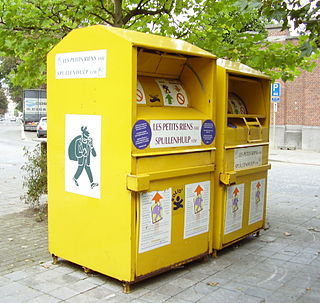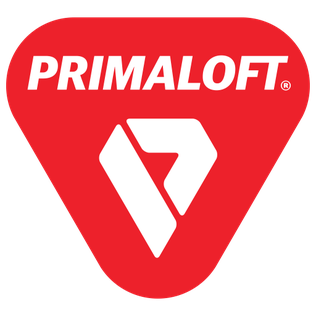Related Research Articles

Although PET is used in several applications,, as of 2022 only bottles are collected at a substantial scale. The main motivations have been either cost reduction or recycle content of retail goods. An increasing amount is recycled back into bottles, the rest goes into fibres, film, thermoformed packaging and strapping. After sorting, cleaning and grinding, 'bottle flake' is obtained, which is then processed by either:
Sustainability advertising is communications geared towards promoting social, economic and environmental benefits (sustainability) of products, services or actions through paid advertising in media in order to encourage responsible behavior of consumers.
Green marketing is the marketing of products that are presumed to be environmentally safe. It incorporates a broad range of activities, including product modification, changes to the production process, sustainable packaging, as well as modifying advertising. Yet defining green marketing is not a simple task where several meanings intersect and contradict each other; an example of this will be the existence of varying social, environmental and retail definitions attached to this term. Other similar terms used are environmental marketing and ecological marketing.
Fast fashion is a term used to describe the clothing industry business model of replicating recent catwalk trends and high-fashion designs, mass-producing them at low cost, and bringing them to retail stores quickly while demand is highest. The term fast fashion is also used generically to describe the products of the fast fashion business model.
Sustainable procurement is a process whereby organizations meet their needs for goods, services, works and utilities in a way that achieves value for money on a life-cycle basis while addressing equity principles for sustainable development, therefore benefiting societies and the environment across time and geographies. Procurement is often conducted via a tendering or competitive bidding process. The process is used to ensure the buyer receives goods, services or works for the best possible price, when aspects such as quality, quantity, time, and location are compared. Procurement is considered sustainable when organizations broadens this framework by meeting their needs for goods, services, works, and utilities in a way that achieves value for money and promotes positive outcomes not only for the organization itself but for the economy, environment, and society. This framework is also known as the triple bottom line, which is a business accounting framework. The concept of TBL is narrowly prescribed, and even John Elkington, who coined the term in the 1990s, now advocates its recall. Indeed, procurement practitioners have drawn attention to the fact that buying from smaller firms, locally, is an important aspect of sustainable procurement in the public sector. Ethics, culture, safety, diversity, inclusion, justice, human rights and the environment are additionally listed as important aspects of SPP.

Textile recycling is the process of recovering fiber, yarn or fabric and reprocessing the textile material into useful products. Textile waste products are gathered from different sources and are then sorted and processed depending on their condition, composition, and resale value. The end result of this processing can vary, from the production of energy and chemicals to new articles of clothing.

PrimaLoft® is a brand of patented synthetic microfiber thermal insulation material that was developed for the United States Army in the 1980s. PrimaLoft is a registered trademark of PrimaLoft, Inc., the brand's parent company.
Sustainable fashion is an all-inclusive term describing products, processes, activities, and actors aiming to achieve a carbon-neutral fashion industry, built on equality, social justice, animal welfare, and ecological integrity. Sustainable fashion concerns more than just addressing fashion textiles or products. It addresses the entire manner in which clothing is produced, who produces it, and how long the life span of a product is before it reaches the landfill. This sustainable movement combats the large carbon footprint that the fashion industry and fast fashion have created by reducing greenhouse gas emissions. Reducing the environmental impact of fashion can combat air pollution, water pollution and overall climate change that could possibly prevent millions of premature deaths over the next century.

Sustainable packaging is the development and use of packaging which results in improved sustainability. This involves increased use of life cycle inventory (LCI) and life cycle assessment (LCA) to help guide the use of packaging which reduces the environmental impact and ecological footprint. It includes a look at the whole of the supply chain: from basic function, to marketing, and then through to end of life (LCA) and rebirth. Additionally, an eco-cost to value ratio can be useful The goals are to improve the long term viability and quality of life for humans and the longevity of natural ecosystems. Sustainable packaging must meet the functional and economic needs of the present without compromising the ability of future generations to meet their own needs. Sustainability is not necessarily an end state but is a continuing process of improvement.
Supply-chain sustainability is the impact a company’s supply chain can make in promoting human rights, fair labor practices, environmental progress and anti-corruption policies. There is a growing need for integrating sustainable choices into supply-chain management. An increasing concern for sustainability is transforming how companies approach business. Whether motivated by their customers, corporate values or business opportunity, traditional priorities such as quality, efficiency and cost regularly compete for attention with concerns such as working conditions and environmental impact. A sustainable supply chain seizes value chain opportunities and offers significant competitive advantages for early adopters and process innovators.
Sustainability brands are brands that undertake sustainable practises in the workings of their business and champion them.
Sustainable distribution refers to any means of transportation / hauling of goods between vendor and purchaser with lowest possible impact on the ecological and social environment, and includes the whole distribution process from storage, order processing and picking, packaging, improved vehicle loadings, delivery to the customer or purchaser and taking back packaging.
Sustainable consumer behavior is the sub-discipline of consumer behavior that studies why and how consumers do or do not incorporate sustainability priorities into their consumption behavior. It studies the products that consumers select, how those products are used, and how they are disposed of in pursuit of consumers' sustainability goals.
Customer cost refers not only to the price of a product, but it also encompasses the purchase costs, use costs and the post-use costs. Purchase costs consist of the cost of searching for a product, gathering information about the product and the cost of obtaining that information. Usually, the highest use costs arise for durable goods that have a high demand on resources, such as energy or water, or those with high maintenance costs. Post-use costs encompass the costs for collecting, storing and disposing of the product once the item has been discarded.
Sustainability marketing myopia is a term used in sustainability marketing referring to a distortion stemming from the overlooking of socio-environmental attributes of a sustainable product or service at the expenses of customer benefits and values. Sustainability marketing is oriented towards the whole community, its social goals and the protection of the environment. It requires the engagement of national and local governments, organisations and population as well as the necessary capital. The idea of sustainability marketing myopia is rooted into conventional marketing myopia theory, as well as green marketing myopia.
Life cycle thinking is an approach to becoming mindful of how everyday life affects the environment. This approach evaluates how both consuming products and engaging in activities impacts the environment. It not only evaluates them at one single step, but takes a holistic picture of an entire product or activity system. This means when talking about a product and taking a life cycle thinking approach, what is actually being evaluated is the impact of the activity of consuming that product. This is because by consuming a product, a series of associated activities are required to make it happen—the raw material extraction, material processing, transportation, distribution, consumption, reuse/recycling, and disposal must all be considered when evaluating the environmental impact. This is called the life cycle of a product. The overall idea of making a holistic evaluation of a system's effect can be defined as life cycle thinking.
Environmental certification is a form of environmental regulation and development where a company can voluntarily choose to comply with predefined processes or objectives set forth by the certification service. Most certification services have a logo which can be applied to products certified under their standards. This is seen as a form of corporate social responsibility allowing companies to address their obligation to minimise the harmful impacts to the environment by voluntarily following a set of externally set and measured objectives.
Green consumption is related to sustainable development or sustainable consumer behaviour. It is a form of consumption that safeguards the environment for the present and for future generations. It ascribes to consumers responsibility or co-responsibility for addressing environmental problems through the adoption of environmentally friendly behaviors, such as the use of organic products, clean and renewable energy, and the choice of goods produced by companies with zero, or almost zero, impact.
Globalization of supply chains and pressure to lower production costs have negatively impacted environments and communities around the world, especially in developing nations where production of high demand goods is increasingly taking place. Since the 1990s, awareness of these negative impacts has grown, leading stakeholders to push companies to take responsibility and actively work to improve the sustainability of their supply chains. It has come to be understood that a company is only as sustainable as the start of its supply chain, bringing about the need for sustainable sourcing. Sustainable sourcing refers to the inclusion of social, environmental, and economic criteria in the sourcing process.
SHEIN was founded by Chris Xu in 2012 and is a self-proclaimed "global fashion and lifestyle e-tailer committed to making the beauty of fashion accessible to everyone". They use "on-demand manufacturing technology" that relies on algorithms and data science to keep up with the latest trends, adding over 2,800 new styles to their collection each week. The company's popularity skyrocketed in 2020 during the COVID-19 pandemic. In the same year, it overtook retail giant Amazon as the most downloaded shopping app in the world.
References
- ↑ Looking Back, Looking Forward: Lessons in Choice Editing for Sustainability (PDF) (Report). Sustainable Development Commission. May 2006. p. 2. Archived from the original (PDF) on 2011-09-28. Retrieved 2011-06-30.
- 1 2 Maniates, Michael. "Editing out Unsustainable Behavior" (PDF). Archived from the original (PDF) on 2011-09-28. Retrieved 2011-06-30.
- 1 2 3 4 5 Sustainable consumption facts and trends: from a business perspective (Report). World Business Council for Sustainable Development. 2008.
- 1 2 "State of the World: Transforming Cultures from Consumerism to Sustainability" (PDF). The Worldwatch Institute. 2010.
- ↑ "Choice Editing". The Danish Environmental Protection Agency. 20 January 2011. Archived from the original on 28 September 2011. Retrieved 30 June 2011.
- ↑ Belz, Frank-Martin; Peattie, Ken (2009). Sustainability Marketing: A Global Perspective. UK: John Wiley & Sons.
- ↑ Hickman, L. (25 October 2007). "Does the consumer really know?". The Guardian. Retrieved 30 June 2011.